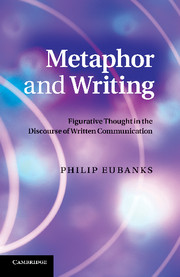Book contents
- Frontmatter
- Contents
- List of figures
- List of tables
- Acknowledgements
- Introduction
- 1 In search of the figurative rhetoric of writing
- 2 The double bind of writer and to write: Graded categories
- 3 Bind upon bind: The general-ability and the specific-expertise views of writing
- 4 Three licensing stories: The literate inscriber, the good writer, and the author writer
- 5 Writing as transcription, talk, and voice: A complex metonymy
- 6 The writing self: Conceptual blends, multiple selves
- 7 Writing to “get ideas across”: The role of the Conduit Metaphor
- 8 Codes and conversations: The other Conduit Metaphor
- 9 Metaphor and choice
- References
- Index
2 - The double bind of writer and to write: Graded categories
Published online by Cambridge University Press: 06 December 2010
- Frontmatter
- Contents
- List of figures
- List of tables
- Acknowledgements
- Introduction
- 1 In search of the figurative rhetoric of writing
- 2 The double bind of writer and to write: Graded categories
- 3 Bind upon bind: The general-ability and the specific-expertise views of writing
- 4 Three licensing stories: The literate inscriber, the good writer, and the author writer
- 5 Writing as transcription, talk, and voice: A complex metonymy
- 6 The writing self: Conceptual blends, multiple selves
- 7 Writing to “get ideas across”: The role of the Conduit Metaphor
- 8 Codes and conversations: The other Conduit Metaphor
- 9 Metaphor and choice
- References
- Index
Summary
First, try to be something, anything, else. A movie star/astronaut. A movie star/missionary. A movie star/kindergarten teacher. President of the World. Fail miserably. It is best if you fail at an early age – say, 14.
Lorrie Moore, “How to become a writer”Dear Mr. Blue,
I always imagined that I would be a writer. Unfortunately, I just don't write and can't even seem to begin. This past winter the idea of becoming an architect jumped into my head. I want to believe that I have some great artistic calling and that when I hear the call it will be unmistakable. I do think architecture is fascinating, and I have passionate feelings about how things should be built, but it doesn't seem to fit my heart like the idea of writing a story does. What do you think? Do only great people get called?
Hearing VoicesDear Hearing,
It strikes me that, more than enjoying the process, you may desire the outcome. You don't want to write, you want to have written. That isn't a calling; it's just plain covetousness. Get over it.
Garrison Keillor, Mr. BlueTurn to almost any page in any book about writing, or listen to any conversation between people who care about writing, and you are likely to come across a metaphor that is familiar or striking – or both. In a single paragraph of the time-honored The Elements of Style, we encounter words that “ignite” and “explode in the mind,” prose that is like “music … capable of stirring the listener deeply,” writing that is done “clearly,” and writers who “steer by the stars” (Strunk and White 2008: 66).
- Type
- Chapter
- Information
- Metaphor and WritingFigurative Thought in the Discourse of Written Communication, pp. 26 - 40Publisher: Cambridge University PressPrint publication year: 2010

